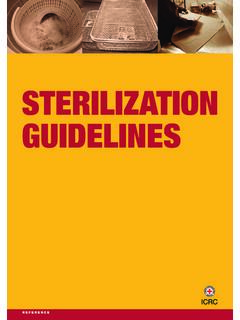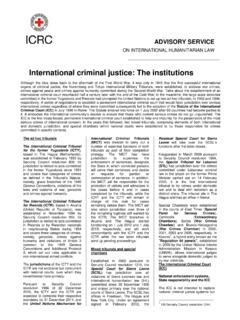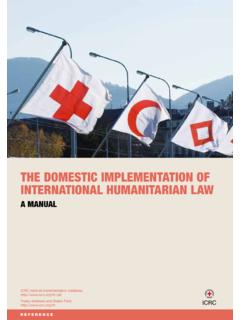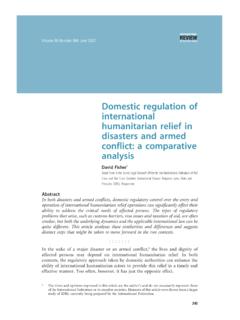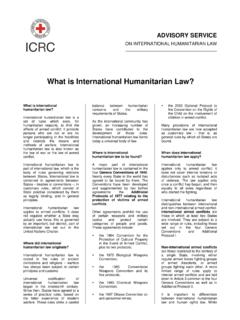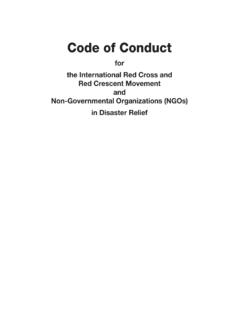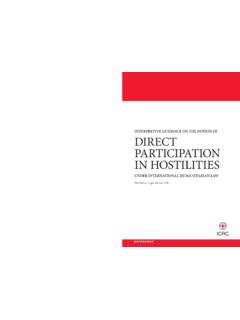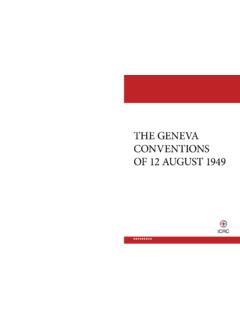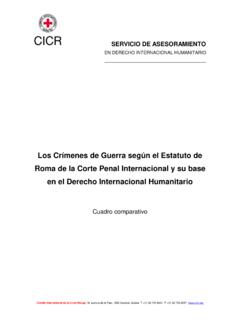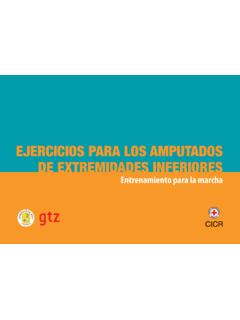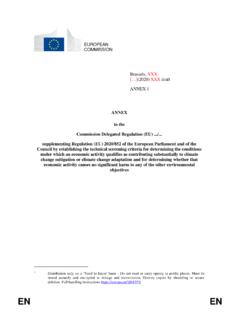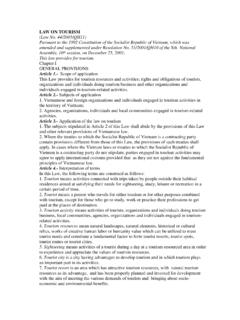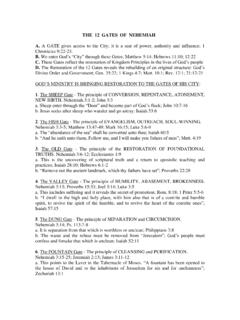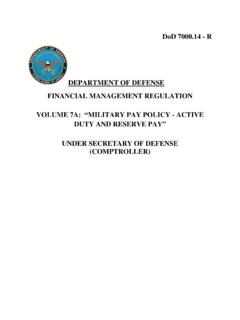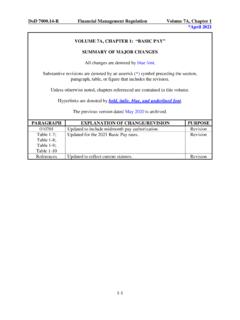Transcription of INTERNATIONAL HUMANITARIAN LAW
1 INTERNATIONAL HUMANITARIAN LAW. Answers to your Questions 2. THE INTERNATIONAL COMMITTEE OF THE RED CROSS (ICRC). Founded by five Swiss citizens in 1863 (Henry Dunant, Basis for ICRC action Guillaume-Henri Dufour, Gustave Moynier, Louis Appia and Th odore Maunoir), the ICRC is the founding member of the During INTERNATIONAL armed conflicts, the ICRC bases its work on INTERNATIONAL Red Cross and Red Crescent Movement. the four Geneva Conventions of 1949 and Additional Protocol I. of 1977 (see Q4). Those treaties lay down the ICRC's right to It is an impartial, neutral and independent HUMANITARIAN institution. carry out certain activities such as bringing relief to wounded, It was born of war over 130 years ago. sick or shipwrecked military personnel, visiting prisoners of war, It is an organization like no other. aiding civilians and, in general terms, ensuring that those Its mandate was handed down by the INTERNATIONAL community.
2 Protected by HUMANITARIAN law are treated accordingly. It acts as a neutral intermediary between belligerents. As the promoter and guardian of INTERNATIONAL HUMANITARIAN law, During non- INTERNATIONAL armed conflicts, the ICRC bases its work it strives to protect and assist the victims of armed conflicts, on Article 3 common to the four Geneva Conventions and internal disturbances and other situations of internal violence. Additional Protocol II (see Index). Article 3 also recognizes the ICRC's right to offer its services to the warring parties with a view The ICRC is active in about 80 countries and has some 11,000 to engaging in relief action and visiting people detained in staff members (2003). connection with the conflict. The ICRC and the Movement In violent situations not amounting to an armed conflict (internal disturbances and other situations of internal violence), the ICRC.
3 The INTERNATIONAL Committee of the Red Cross (ICRC) and the bases its work on Article 5 of the Movement's Statutes, which National Red Cross and Red Crescent Societies, together with the sets out among other things the ICRC's right of HUMANITARIAN INTERNATIONAL Federation of Red Cross and Red Crescent Societies initiative. That right may also be invoked in INTERNATIONAL and (the Federation), combine to form the INTERNATIONAL Red Cross non- INTERNATIONAL armed conflicts. and Red Crescent Movement (the Movement). As a rule, representatives of those organizations meet every four years with All these articles and laws together form the mandate given to the representatives of the States party to the Geneva Conventions at ICRC by the INTERNATIONAL community, by the States. an INTERNATIONAL Conference of the Red Cross and Red Crescent. INTERNATIONAL Committee of the Red Cross 19 Avenue de la Paix 1202 Geneva, Switzerland T +41 22 734 6001 F +41 22 733 2057.
4 E-mail: Original: English October 2002. SUMMARY OF QUESTIONS. 1. What is INTERNATIONAL HUMANITARIAN law? 4. 2. What are the essential rules of INTERNATIONAL HUMANITARIAN law? 6. 3. What are the origins of INTERNATIONAL HUMANITARIAN law? 8. 4. What treaties make up INTERNATIONAL HUMANITARIAN law? 10. 5. Who is bound by the Geneva Conventions? 12. 6. What are jus ad bellum and jus in bello? 14. 7. In what situations does HUMANITARIAN law apply? For whom is it intended and who does it protect? 16. 8. Does HUMANITARIAN law apply to the new conflicts? 18. 9. How does HUMANITARIAN law adapt to new developments and what is the ICRC's role in the process? 20. 10. What does HUMANITARIAN law provide for in terms of material assistance to the victims of armed conflict? 22. 11. What does HUMANITARIAN law say with regard to the restoration of family links? 24. 12.
5 What are the provisions of HUMANITARIAN law governing use of the emblem? 26. 13. How does HUMANITARIAN law protect refugees and internally displaced persons? 28. 14. What measures are available for implementing HUMANITARIAN law? 30. 15. What is the ICRC's role in ensuring respect for HUMANITARIAN law? 32. 16. How are war criminals prosecuted under HUMANITARIAN law? 34. 17. What is the difference between HUMANITARIAN law and human rights law? 36. 18. Does HUMANITARIAN law apply to peace-keeping and peace-enforcement operations carried out by or under the auspices of the United Nations? 38. 19. What does HUMANITARIAN law say about terrorism? 39. Index 40. Bibliography 41. 3. 4. ICRC. Care for all wounded on the battlefield. 1 WHAT IS INTERNATIONAL HUMANITARIAN LAW? INTERNATIONAL HUMANITARIAN law forms a More precisely, what the ICRC means by nature ; for HUMANITARIAN reasons those rules major part of public INTERNATIONAL law (see INTERNATIONAL HUMANITARIAN law applicable in restrict the right of the parties to a conflict to opposite) and comprises the rules which, armed conflicts is INTERNATIONAL treaty or use the methods and means of warfare of in times of armed conflict, seek to protect customary rules which are specially intended their choice, and protect people and property people who are not or are no longer taking to resolve matters of HUMANITARIAN concern affected or liable to be affected by the conflict part in the hostilities, and to restrict the arising directly from armed conflicts, whether (see Q3, Q6 and Q17, which provide useful methods and means of warfare employed.)
6 Of an INTERNATIONAL or non- INTERNATIONAL additional information). Geneva and The Hague Who fights whom? INTERNATIONAL HUMANITARIAN law (IHL) also known as the law An INTERNATIONAL armed conflict means fighting between the armed of armed conflicts or law of war (see Terminology opposite), forces of at least two States (it should be noted that wars of national has two branches: liberation have been classified as INTERNATIONAL armed conflicts). the law of Geneva , which is designed to safeguard military personnel who are no longer taking part in the fighting and A non- INTERNATIONAL armed conflict means fighting on the people not actively involved in hostilities, civilians; territory of a State between the regular armed forces and the law of The Hague , which establishes the rights and identifiable armed groups, or between armed groups fighting obligations of belligerents in the conduct of military one another.
7 To be considered a non- INTERNATIONAL armed operations, and limits the means of harming the enemy. conflict, fighting must reach a certain level of intensity and extend over a certain period of time. The two branches of IHL draw their names from the cities where each was initially codified. With the adoption of the Internal disturbances are characterized by a serious disruption of Additional Protocols of 1977, which combine both branches, internal order resulting from acts of violence which nevertheless that distinction is now of merely historical and didactic value. are not representative of an armed conflict (riots, struggles between factions or against the authorities, for example). I N T E R N AT I O N A L H U M A N I TA R I A N L AW. Grotius and the law of nations In current parlance, the law of nations is synonymous with the relations. The law of nations was to provide that principle.
8 In term public INTERNATIONAL law or INTERNATIONAL law , which is the his book De jure belli ac pacis, Grotius listed rules which are body of rules governing relations between States and between among the firmest foundations of the law of war. them and other members of the INTERNATIONAL community. Terminology Grotius (see Index), a jurist and diplomat, was the father of the The expressions INTERNATIONAL HUMANITARIAN law, law of armed law of nations. Following the Reformation, which divided the conflicts and law of war may be regarded as equivalents. Christian church in Europe, he took the view that the law was INTERNATIONAL organizations, universities and even States will no longer an expression of divine justice but the fruit of human tend to favor INTERNATIONAL HUMANITARIAN law (or HUMANITARIAN reason and that it no longer preceded action but arose from it.)
9 Law), whereas the other two expressions are more commonly Hence the need to find another uniting principle for INTERNATIONAL used by the armed forces. Human Refugee rights law law Laws governing INTERNATIONAL the peaceful Maritime HUMANITARIAN settlement of law law conflicts Laws Laws governing Environmental governing diplomatic law air space relations Laws Laws Laws governing governing governing State INTERNATIONAL economic responsibility organizations relations This figure is not to be interpreted as an attempt to classify or rank the various branches of public INTERNATIONAL law; it merely mentions some of the more well-known ones. 5. 6. Thomas Pizer/ICRC..as soon as they lay down [their arms] and surrender, they cease to be enemies or agents of the enemy, and again become mere men, and it is no longer legitimate to take their lives.. 2 WHAT ARE THE ESSENTIAL RULES.
10 OF INTERNATIONAL HUMANITARIAN LAW? The parties to a conflict must at all times Neither the parties to the conflict nor Captured combatants and civilians who distinguish between the civilian population members of their armed forces have an find themselves under the authority of the and combatants in order to spare the unlimited right to choose methods and adverse party are entitled to respect for their civilian population and civilian property. means of warfare. It is forbidden to use lives, their dignity, their personal rights and Neither the civilian population as a whole weapons or methods of warfare that are their political, religious and other nor individual civilians may be attacked. likely to cause unnecessary losses or convictions. They must be protected Attacks may be made solely against excessive suffering. against all acts of violence or reprisal.
